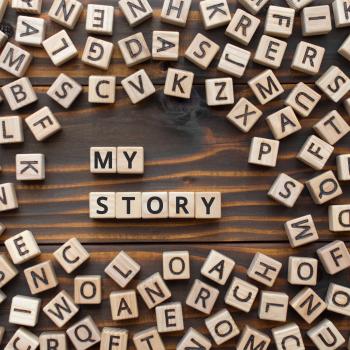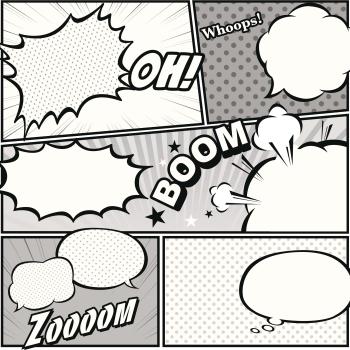The traditional autobiography writing project is given a twist as students write alphabiographiesrecording an event, person, object, or feeling associated with each letter of the alphabet.

Alphabiography Project: Totally You

Grades
|
From Dr. Seuss to Jonathan Swift: Exploring the History behind the Satire
9 - 12
Lesson Plan
| Standard Lesson
Use Dr. Seuss's The Butter Battle Book as an accessible introduction to satire. Reading, discussing, and researching this picture book paves the way for a deeper understanding of Gulliver's Travels.

Grades
|
Decoding the Dystopian Characteristics of Macintosh's "1984" Commercial
9 - 12
Lesson Plan
| Minilesson
This lesson uses the "1984" Macintosh Commercial to introduce students to dystopian characteristics. Students analyze techniques used in the commercial and identify the comments that it makes about contemporary society.

Grades
|
Book Report Alternative: A Character's Letter to the Editor
6 - 8
Lesson Plan
| Standard Lesson
Students write a persuasive letter to the editor of a newspaper from a selected fictional character's perspective, focusing on a specific issue or situation explored in the novel.

Grades
|
Persuading an Audience: Writing Effective Letters to the Editor
9 - 12
Lesson Plan
| Standard Lesson
Students use persuasive writing and an understanding of the characteristics of letters to the editor to compose effective letters to the editor on topics of interest to them.

Grades
|
Finding the Science Behind Science Fiction through Paired Readings
6 - 8
Lesson Plan
| Standard Lesson
Students read science fiction texts and then use nonfiction texts to extrapolate the scientific principles presented as they discuss the "what ifs" within the context of scientific principles.

Grades
|
Decoding The Matrix Exploring Dystopian Characteristics through Film
9 - 12
Lesson Plan
| Standard Lesson
This lesson uses clips from The Matrix and other dystopian movies to introduce students to the characteristics found in dystopian works, such as Brave New World, Fahrenheit 451, and 1984.

Grades
|
Analyzing the Stylistic Choices of Political Cartoonists
9 - 12
Lesson Plan
| Standard Lesson
Students explore and analyze the techniques that political (or editorial) cartoonists use and draw conclusions about why the cartoonists choose those techniques to communicate their messages.

Grades
|
Outside In: Finding A Character's Heart Through Art
9 - 12
Lesson Plan
| Standard Lesson
This activity, inspired by the paintings of Edward Hopper and the stories of Raymond Carver, challenges students to get inside contemporary life and characters through the creation of monologues.

Grades
|
The Comic Book Show and Tell
9 - 12
Lesson Plan
| Standard Lesson
Students craft comic scripts using clear, descriptive, and detailed writing that shows (illustrates) and tells (directs). After peers create an artistic interpretation of the script, students revise their original scripts.

Grades
|
Digging Up Details on Worms: Using the Language of Science in an Inquiry Study
K - 2
Lesson Plan
| Standard Lesson
This lesson, in which students research worms in order to create a classroom habitat, incorporates reading and writing across content areas as well as math and science activities.

Grades
|
Defining Literacy in a Digital World
9 - 12
Lesson Plan
| Standard Lesson
Through listing and observation, students identify the many texts that they read and composeincluding books and magazines, television shows, movies, audio broadcasts, hypertexts, and animations.

Grades
|
Exploring Language and Identity: Amy Tan's "Mother Tongue" and Beyond
9 - 12
Lesson Plan
| Standard Lesson
Students explore the idea of "different Englishes" by reading Amy Tan's "Mother Tongue" and writing literacy narratives about their own use of different language for different audiences and purposes.

Grades
|
Onomatopoeia: A Figurative Language Minilesson
9 - 12
Lesson Plan
| Minilesson
Clang, clash, or tinkle? Students explore the use of onomatopoeia in Edgar Allan Poe's "The Bells" before choosing their own sound words in response to specific sounds.

Grades
|
Writing about Writing: An Extended Metaphor Assignment
9 - 12
Lesson Plan
| Standard Lesson
After discussing the poem "The Writer" by Richard Wilbur, students analyze their own writing habits and create an extended metaphor describing themselves as writers.

Grades
|
Plot Structure: A Literary Elements Mini-Lesson
6 - 8
Lesson Plan
| Standard Lesson
Students learn that the plot structure described by Freytag's Pyramid is actually quite familiar as they diagram the plots of a familiar story, a television show, and a narrative poem.

Grades
|
Draft Letters: Improving Student Writing through Critical Thinking
9 - 12
Lesson Plan
| Minilesson
Draft letters ask students to think critically about their writing on a specific assignment before submitting their work to a reader. This lesson explains and provides models for the strategy.

Grades
|
Audio Broadcasts and Podcasts: Oral Storytelling and Dramatization
9 - 12
Lesson Plan
| Unit
After exploring Orson Welles' 1938 broadcast of H. G. Wells' War of the Worlds, students create their own audio dramatization of a text they have read.

Grades
|
You're the Top! Pop Culture Then and Now
9 - 12
Lesson Plan
| Minilesson
Students analyze the lyrics to Cole Porter's "You're the Top!" and then update them to include current "tops" in pop culture.

Grades
|
Put That on the List: Independently Writing a Catalog Poem
9 - 12
Lesson Plan
| Standard Lesson
In this follow-up to writing collaborative catalog poems, students write individual catalog poems about what really matters in their lives, based on Carver's poem "The Car."